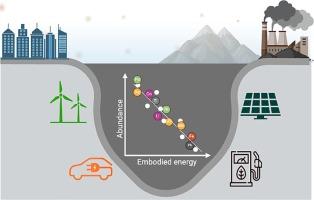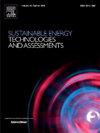The power law of resource abundance and their corresponding extraction: Evidence to be accounted in the frame of the critical raw materials initiatives for the energy transition
IF 7.1
2区 工程技术
Q1 ENERGY & FUELS
Sustainable Energy Technologies and Assessments
Pub Date : 2024-10-18
DOI:10.1016/j.seta.2024.104022
引用次数: 0
Abstract
Responsible sourcing of minerals and metals is critical for the transition to a low-carbon energy system. The increased demand for these materials requires a shift towards more efficient and environmentally friendly mining practices, as well as better recycling and reuse of these materials. Based on a transdisciplinary approach, in this work, the power law, normally used to model biological systems, is applied for the first time to model the relationship between the abundance of strategic elements and their extraction, at different times (in 1999 and 2023). An increase in the exponent of the power law when analyzing materials production data in 1999 and 2023 (the data can be fitted by two power laws with an exponent of 0.61 and 0.74, respectively) suggests changes in production dynamics, which could be driven by factors such as increased demand, improved efficiency, resource diversification, regulatory changes, market dynamics, or environmental considerations. Understanding these changes is crucial for assessing the sustainability and long-term viability of material production systems. Overall, the proposed power law offers a valuable framework for analyzing the dynamic relationship between material abundance and production over time, providing insights that can inform decision-making and support efforts toward sustainable resource management and economic development. This is particularly important with the recently established policies about the increase of mining activities in the EU countries.
Based on these findings, this study suggests several priority actions, to achieve the objectives of the Critical Raw Materials Act, thereby enhancing the effectiveness of the proposed European plan to increase the availability of strategic materials. This involves diversifying resource inputs, promoting renewable and alternative materials, and adopting practices that prioritize conservation and responsible stewardship of natural resources.

资源丰度及其相应开采的幂律:在能源转型关键原材料倡议框架内应考虑的证据
负责任地采购矿物和金属对于向低碳能源系统过渡至关重要。随着对这些材料需求的增加,需要向更高效、更环保的采矿方式转变,并更好地回收和再利用这些材料。基于跨学科方法,本研究首次将通常用于模拟生物系统的幂律用于模拟不同时期(1999 年和 2023 年)战略元素丰度与开采量之间的关系。在分析 1999 年和 2023 年的材料生产数据时,幂律指数的增加(数据可由指数分别为 0.61 和 0.74 的两个幂律拟合)表明生产动态发生了变化,其驱动因素可能是需求增加、效率提高、资源多样化、监管变化、市场动态或环境因素。了解这些变化对于评估材料生产系统的可持续性和长期可行性至关重要。总体而言,拟议的幂律为分析材料丰度与生产之间随时间变化的动态关系提供了一个宝贵的框架,可为决策提供依据,并为实现可持续资源管理和经济发展提供支持。基于这些发现,本研究提出了几项优先行动建议,以实现《关键原材料法》的目标,从而提高拟议欧洲计划的有效性,增加战略材料的可用性。这包括使资源投入多样化,推广可再生和替代材料,以及采取优先保护和负责任地管理自然资源的做法。
本文章由计算机程序翻译,如有差异,请以英文原文为准。
求助全文
约1分钟内获得全文
求助全文
来源期刊

Sustainable Energy Technologies and Assessments
Energy-Renewable Energy, Sustainability and the Environment
CiteScore
12.70
自引率
12.50%
发文量
1091
期刊介绍:
Encouraging a transition to a sustainable energy future is imperative for our world. Technologies that enable this shift in various sectors like transportation, heating, and power systems are of utmost importance. Sustainable Energy Technologies and Assessments welcomes papers focusing on a range of aspects and levels of technological advancements in energy generation and utilization. The aim is to reduce the negative environmental impact associated with energy production and consumption, spanning from laboratory experiments to real-world applications in the commercial sector.
 求助内容:
求助内容: 应助结果提醒方式:
应助结果提醒方式:


